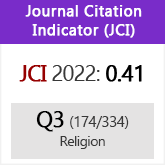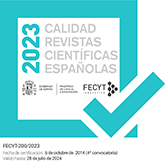Los manuscritos del segundo comentario a génesis de Abraham ibn ʿEzra en el contexto de la censura en la Italia del siglo XVI
DOI:
https://doi.org/10.3989/sefarad.023-008Palabras clave:
censura, Abraham ibn ʿEzra, Domenico YĕrušalmiResumen
El segundo comentario a Génesis es un trabajo incompleto exegético-gramatical escrito en Ruán por el erudito andalusí Abraham ibn ʿEzra. A diferencia de su primer comentario compuesto en Lucca, de esta obra se conocen hasta el momento tan solo seis manuscritos de entre los siglos XIV y XVII, tres de los cuales han sido censurados. Los códices que contienen el texto censurado fueron elaborados en Italia durante el período de la Contrarreforma en el que la literatura hebrea fue supervisada por la Iglesia Católica. El objetivo de este trabajo es analizar la presencia de censura interna y externa en los manuscritos del Segundo Comentario del Génesis de Ibn ʿEzra en el contexto de la producción textual hebrea del siglo XVI en Italia. Además, este trabajo intentará establecer una posible relación entre el contenido de las secciones perdidas y el llamado Sefer ha-Ziqquq, el Index Librorum Prohibitorum más importante de los libros hebreos escrito por el rabino apóstata Domenico Yĕrušalmi, cuya firma se encuentra en los códices.
Descargas
Citas
Amram, David Werner (1909): The Makers of Hebrew Books in Italy: Being Chapters in the History of the Hebrew Printing Press (Philadelphia: J. H. Greenstone).
Baruchson-Arbib, Shifra and Gila Prebor (2007): «Sefer ha-Ziquq (An Index of Forbidden Hebrew Books): the Book's use and its influence on Hebrew Printing», La Bibliofilía 109:1, pp. 3-31.
Cantera Montenegro, Enrique (2004): «Abraham ibn Ezra en las crónicas hispanohebreas», Kalakorikos 9, pp. 241-255.
Chazan, Robert (1969): «Jewish Settlement in Northern France 1006-1306», Revue des études juives 128, 1, pp. 41-65. https://doi.org/10.3406/rjuiv.1969.1620
Chazan, Robert (2010): The Jews of Medieval Western Christendom: 1000-1500, 3rd ed. (Cambridge: Cambridge University Press).
Chazan, Robert (2012): Reassessing Jewish Life in Medieval Europe, 2nd ed. (Cambridge: Cambridge University Press).
Cohen, Mordechai Z. (2020): The Rule of Peshat: Jewish Constructions of the Plain Sense of Scripture and Their Christian and Muslim Context 900-1270 (Philadelphia: University of Pennsylvania Press). https://doi.org/10.9783/9780812297010
Eckardt, Alice L. (1989): «The Reformation and the Jews», Shofar 7:4, pp. 23-47.
Francesconi, Federica (2012): «"This passage can also be read differently...:" How Jews and Christians censored Hebrew texts in early modern Modena», Jewish History 26:1/2, pp. 139-160. https://doi.org/10.1007/s10835-012-9147-5
Freudenthal, Gad (2013): «Abraham ibn Ezra and Judah Ibn Tibbon as Cultural Intermediaries: Early Stages in the Introduction of Non-Rabbinic Learning into Provence in the Mid-Twelfth Century», in Exchange and Transmission across Cultural Boundaries: Philosophy, Mysticism and Science in the Mediterranean World. Proceedings of an International Workshop Held in Memory of Professor Shlomo Pines at the Institute for Advanced Studies. The Hebrew University of Jerusalem, 28 February-2 March 2005, ed. Haggai Ben-Shammai, Sarah Stroumsa y Shaul Shaked (Jerusalem: The Israel Academy of Sciences and Humanities), pp. 52-81.
Friëdlander, Michael (1877): Essays on the writings of Abraham Ibn Ezra (London: The Society of Hebrew Literature by Trübner).
Golb, Norman (1985): Les Juifs de Rouen au Moyen Âge: Portrait d'une culture oubliée (Mont-Saint-Aignan: Publications de l'Université de Rouen). https://doi.org/10.4000/books.purh.8473
Golb, Norman (1986): «Addendum (to Paajr, XLVIII [1981], pp. 101-182): Nature et Destination Du Monument Hebraique Decouvert a Rouen», Proceedings of the American Academy for Jewish Research 53, pp.71-89. https://doi.org/10.2307/3622609
Golb, Norman (2012): The Jews in Medieval Normandy: A Social and Intellectual History (Cambridge: Cambridge University Press).
Gómez Aranda, Mariano (2012): «Los comentarios bíblicos de Abraham ibn Ezra», Iberia Judaica 4, pp. 81-104.
Gómez Aranda, Mariano (2017): «Abraham ibn Ezra o el saber errante», El Olivo 85-86, pp. 49-74.
Gruber, I. Mayer (2004): Raši's Commentary on Psalms (Leiden: Brill). https://doi.org/10.1163/9789047412649
Helm, Jennifer (2015): Poetry and Censorship in Counter-Reformation Italy (Leiden: Brill). https://doi.org/10.1163/9789004301115
Ioly Zorattini, Pier Cesare (1998): «Domenico Gerosolimitano a Venezia», Sefarad 58:1, pp. 107-115. https://doi.org/10.3989/sefarad.1998.v58.i1.836
Lancaster, Irene (2003): Deconstructing the Bible: Abraham ibn Ezra's introduction to the Torah (London: Routledge).
Marcus, Ivan G. (2001): «The Dynamics of Jewish Renaissance and Renewal in the Twelfth Century», in Jews and Christians in Twelfth-century Europe, ed. Michael A. Signer and John van Engen (Notre Dame: University of Notre Dame Press) pp. 27-45.
Martínez de Bujanda, Jesús (2002): Index Librorum Prohibitorum 1600-1966 (Sherbrooke: Centre d'études de la Renaissance, Editions de l'Université de Sherbrooke).
Olalla Molinero, Víctor (1974): «Una familia de hebraístas: los Buxtorf de Basilea», Miscelánea de Estudios Árabes y Hebraicos. Sección Hebreo 23, pp. 81-92.
Po-Chia Hsia, Ronald (2017): «Judaism and Protestantism», in The Cambridge History of Judaism, ed. Jonathan Karp y Adam Sutcliffe (Cambridge: Cambridge University Press). https://doi.org/10.1017/9781139017169.004
Popper, William (1899): The Censorship of Hebrew Books (New York: The Knickerbocker Press).
Prebor, Gila (2008): «ספר הזיקוק של דומיניקו ירושלמי», Italia 18, pp. 7-296.
Prebor, Gila (2011): «Domenico Yerushalmi: His life, Writings and Work as a Censor», Materia Giudaica 15-16, pp. 467-481.
Raz-Krakotzkin, Amnon (2004): «The Censor as a Mediator: Printing, Censorship and the Shaping of Hebrew Literature», in The Roman Inquisition, the Index and the Jews: Contexts, Sources and Perspectives, ed. Stephan Wendehost (Leiden: Brill). https://doi.org/10.1163/9789047406228_005
Raz-Krakotzkin, Amnon (2007): The Censor, the Editor and the Text: The Catholic Church and the Shaping of the Jewish Canon in the Sixteenth Century (Philadelphia: University of Pennsylvania Press).
Sacerdote, Gustavo (1895): «Deux index expurgatoires de livres hébreux», Revue des études juives 30:60, pp. 257-283. https://doi.org/10.3406/rjuiv.1895.4042
Sáenz-Badillos, Ángel (2006): «El pensamiento económico de los judíos en la Edad Media», Mediterráneo económico 9, pp. 117-133.
Sáenz-Badillos, Ángel and Judit Targarona Borrás (2016): Los judíos de Sefarad ante la Biblia (Barcelona: Herder).
Sapir Abulafia, Anna (2014): Christians and Jews in the Twelfth-Century Renaissance (London: Routledge). https://doi.org/10.4324/9780203202333
Sela, Shlomo and Gad Freudenthal (2006): «Abraham Ibn Ezra's Scholarly Writings: A Chronological Listing», Aleph: Historical Studies in Science & Judaism 6, pp. 13-55. https://doi.org/10.2979/ALE.2006.-.6.13
Sutcliffe, Adam (2000): «Hebrew Texts and Protestant Readers: Christian Hebraism and Denominational Self-Definition», Jewish Studies Quarterly 7:4, pp. 319-337.
Tello, León, trans. (1989): Yosef ha-Kohen, El valle del llanto: crónica hebrea del siglo XVI (Barcelona: Riopiedras).
Walton, Michael T. and Phyllis J. Walton (1990): «In Defense of the Church Militant: The Censorship of the Rashi Commentary in the Magna Biblia Rabbinica», The Sixteenth Century Journal 21:3, pp. 385-400. https://doi.org/10.2307/2540275
Weiser, Asher (1976): Ibn Ezra's Commentary on the Torah, vol. 1 (Jerusalem: Mossad Harav Kook).
Descargas
Publicado
Cómo citar
Número
Sección
Licencia
Derechos de autor 2024 Consejo Superior de Investigaciones Científicas (CSIC)

Esta obra está bajo una licencia internacional Creative Commons Atribución 4.0.
© CSIC. Los originales publicados en las ediciones impresa y electrónica de esta Revista son propiedad del Consejo Superior de Investigaciones Científicas, siendo necesario citar la procedencia en cualquier reproducción parcial o total.Salvo indicación contraria, todos los contenidos de la edición electrónica se distribuyen bajo una licencia de uso y distribución “Creative Commons Reconocimiento 4.0 Internacional ” (CC BY 4.0). Puede consultar desde aquí la versión informativa y el texto legal de la licencia. Esta circunstancia ha de hacerse constar expresamente de esta forma cuando sea necesario.
No se autoriza el depósito en repositorios, páginas web personales o similares de cualquier otra versión distinta a la publicada por el editor.
Datos de los fondos
Ministerio de Ciencia, Innovación y Universidades
Números de la subvención PGC2018-094407-B-I00














